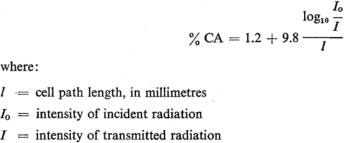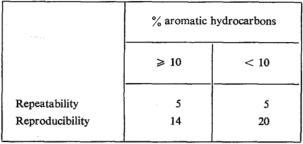1. Scope
This standard deals with the determination of the aromatic hydrocarbon content of new mineral insulating oils.
Two methods are proposed:
- Infrared spectrophotometric analysis
This method is recommended as a quality control and acceptance test for mineral insulating oils. It uses the relationship between the absorbance at 1610 cm(-1) and the n-d-M analysis to determine the proportion of the total carbon atoms present in aromatic ring structures. The conversion factor derived from this relationship is applicable to oils with a molecular mass in the range 290 to 500 and with an aromatic carbon content in the range 1.2 % to 60 %.
- Adsorption chromatographic analysis
This method describes the measurement of the percentage by mass of polar compounds and compounds containing at least one aromatic ring per molecule present in low molecular mass mineral insulating oils.
2. Test methods
2.1 Infrared spectrophotometric analysis
2.1.1 Principle of the method
The infrared absorption spectrum of the sample to be analyzed is recorded and the absorption characteristic of the aromatic ring at 1610 cm(-1) is measured. This absorption is a function of the amount of aromatic carbon.
2.1.2 Apparatus
Infrared spectrophotometer
Double beam spectrophotometer having a resolution better than 3 cm(-1) in the region of 1600 cm(-1).
Cell
Any infrared liquid cell with variable or fixed path length with NaCl windows. The path length will be comprised between 0.05 mm and 0.30 mm and shall be known within +/-0.003 mm, or better.
The most suitable length will be dictated by the content of aromatic hydrocarbons which is to be determined.
The path length can be determined by any procedure described in any handbook on infrared spectrophotometry.
2.1.3 Procedure
a) Adjust the spectrophotometer in accordance with the instructions given in the manufacturer's handbook.
b) Fill the cell with the oil to be examined.
c) Set the cell at the correct place in the spectrophotometer.
d) Record the complete infrared spectrum.
e) Measure the transmitted intensity at 1610 cm(-1) using, as a baseline, the tangent to the spectrum curve at the minima of this absorption band (see Figure 1, page 16).
2.1.4 Calculation of the result
Calculate the aromatic carbon content using the formula:

2.1.5 Precision
The following criteria should be used for judging the acceptability of results (95% confidence).
Repeatability (r): Duplicate results by the same operator should be considered suspect if they differ by more than the amount given in the following table.
Reproducibility (R): The results submitted by each of two laboratories should be considered suspect if the two results differ by more than the amount given in the following table.

2.2 Adsorption chromatography analysis
2.2.1 Principle of the method
The sample diluted in n-pentane is separated on a column filled with activated silica gel.
Two fractions are separated:
a) saturated hydrocarbons (paraffins and naphthenes);
b) polar compounds (aromatic hydrocarbons plus sulphur, oxygen or nitrogen compounds).
2.2.2 Apparatus
Adsorption column (Figure 2, page 17) consisting of a glass tube 50 cm long, having 1 cm internal diameter, drawn out into a taper at one end (internal diameter of the tapered end: 2 mm) and having a bulb of about 50 ml capacity at the upper end.
This column is calibrated with one mark corresponding to the volume of 10 g of silica gel.
- Vacuum pump fitted with a cold trap.
- Graduated measuring cylinders (1 division = 1 ml) of 25 ml capacity.
- Heating device. Any device (water or oil bath, heating mantle) capable of being maintained at any temperature in the range of 50 °C to 100 °C.
- Evaporation flasks.
- Weighing bottle (volume approximately 20 ml).
2.2.3 Reagents
- Silica gel 100 to 200 mesh, activated in an oven at 160 °C for 8 h just before use.
Note The preferred range of pore size will be 2 nm to 4 nm.
- n-pentane, analytical grade.
- ethoxyethane, analytical grade.
2.2.4 Procedure
a) Insert a plug of cotton wool in the lower end of the clean d ry glass adsorption column, to retain the adsorbent.
b) Immediately after being activated, and without being allowed to cool, the silica gel is poured into the column which is tapped gently to compact the silical gel uniformly until the level remains at the 10 g mark.
c) Place a small plug of cotton wool on top of the gel.
Note As far as possible, activated silica gel must be kept away from the moisture of the air (e.g. it is recommended to seal the column during the packing process and the cooling of the adsor be nt).
d) Weigh approximately 0.5 g (to the nearest +/- 0.0002 g) of oil sample into a 20 ml weighing bottle and dilute with 5 ml of n-pentane.
e) Pour 10 ml of n-pentane into the column containing the adsorbent. Elute this solvent and just before the level of the solvent reaches the upper face of the adsorbent add the diluted sample.
f) Thoroughly wash out the weighing bottle with the minimum amount of n-pentane. Pour this solvent into the top of the column.
g) When all the diluted sample has entered the silica gel, add further 10 ml quantities of n-pentane so that the column is never allowed to run dry.
h) Collect the fractions in 25 ml measuring cylinders.
i) After the diluted sample has been added and between 17 ml and 20 ml of n-pentane has been collected, determine the cut point between the saturated and polar compounds (i.e. aromatics) by the following procedure:
- take one drop of the percolate on a Whatman No. 1 filter paper;
- allow the solvent to evaporate;
- if the saturated hydrocarbons are completely eluted, no oil residue will be visible on the paper by transmitted light;
- repeat this every 2 ml until a drop leaves no more oil residue on the filter paper.
j) The fractions eluted from the introduction of the diluted sample until complete elution of saturated hydrocarbons are collected in a previously weighed evaporation flask (fraction 1).
k) Elute the polar compounds still adsorbed in the column with 50 ml ethoxyethane.
l) Collect the eluted fraction in a weighed evaporation flask (fraction 2).
m) The fractions 1 and 2 are separately evaporated first at 50 °C and finally under vacuum (2 torr) at 100 °C (1 torr = 1.3 10(2) Pa) during a sufficient time to get rid of the solvent.
Note During the evaporation care should be taken not to lose light fractions of the sample itself.
n) Weigh the two residues to the nearest ±0.0002 g (mass S for the fraction 1 and mass A for the fraction 2).
Note The procedure has been correctly applied if the sum of the masses of the residues (S + A) is between 98 % and 102% of the mass of the original sample.
2.2.5 Calculation of the result

where:
A = mass (g) of aromatic hydrocarbons (and other polar compounds)
S = mass (g) of saturated hydrocarbons
Note 1 For the application of this method it may be assumed that all polar derivatives are compound hydrocarbons.
Note 2 If, in special cases, the actual aromatic hydrocarbon content must be distinguished from the other polar compounds (i.e. organic compounds containing O, S or N), the following procedure shall be used. One assumes that all oxygen, sulphur and nitrogen compounds contain only one heteroatom (O, S or N) per molecule and have the same mean molecular mass as the insulating oil.
The actual content of aromatic hydrocarbons is the difference between the total aromatic and polar compound content and the content of oxygen, nitrogen and sulphur compounds.
Note 3 If more information is required on the different classes of aromatic hydrocarbons (mono-, di-, polyaromatics and associated polar compounds), a more sophisticated method than that described in this standard may be used for research investigation. For example, the method of Snyder * is recommended.
2.2.6 Precision
The following criteria may be used for judging the acceptability of results (95 % confidence).
Repeatability (r): Duplicate results by the same operator should be considered suspect if they differ by more than the amount given in the following table.
Reproducibility (R): The results submitted by each of two laboratories should be considered suspect if the two results differ by more than the amount given in the following table.




